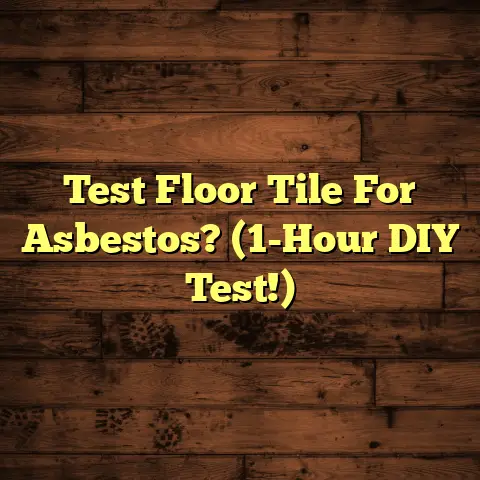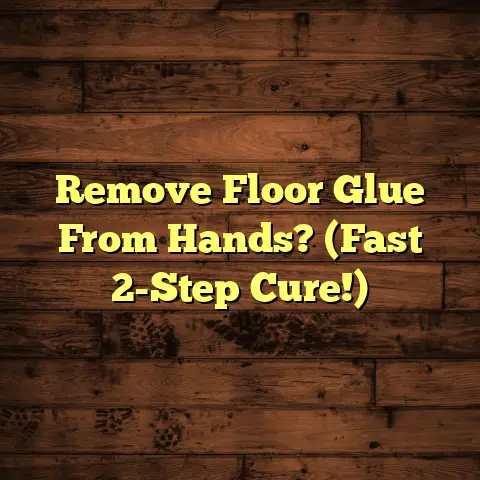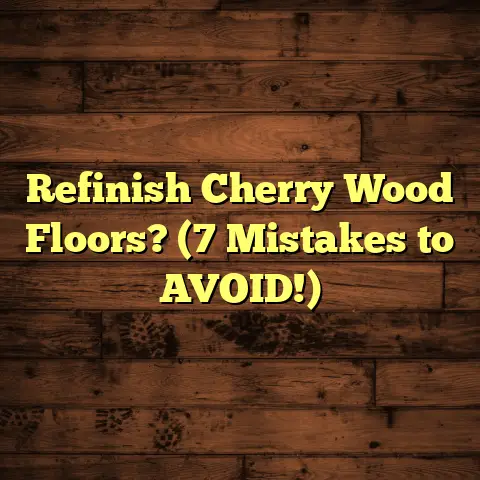Epoxy a Basement Floor? (4 Moisture Tests!)
I’ve seen it all, from dream floors to absolute disasters.
And let me tell you, basements? They’re a whole different ballgame.
Picking the right flooring for your basement can be tricky, especially with moisture lurking around.
But fear not!
I’m here to tell you why I believe epoxy flooring is the best option.
It’s durable, water-resistant, and can seriously transform that dull, damp space into something amazing.
Trust me, I’ve transformed countless basements with epoxy, and it’s a game-changer.
But here’s the kicker: before you even think about epoxy, you need to test for moisture.
Seriously, it’s non-negotiable.
Let’s dive in!
Section 1: Understanding Epoxy Flooring
1. What is Epoxy Flooring?
So, what exactly is epoxy flooring?
Well, it’s not just paint!
Epoxy is a thermosetting polymer that, when mixed with a hardener, undergoes a chemical reaction.
This reaction creates a super-strong, durable, and chemical-resistant surface.
Think of it like liquid plastic that hardens into a rock-solid shield for your floor.
There are several types of epoxy flooring systems perfect for basements:
- Self-Leveling Epoxy: Creates a smooth, seamless surface, great for hiding imperfections.
- Epoxy Flake Flooring: Decorative flakes are added for a textured, slip-resistant finish.
- Metallic Epoxy Flooring: Pigments create a stunning, swirling, marble-like effect.
Each one offers a unique look and feel, so you can customize your basement to your heart’s content.
2. Benefits of Epoxy Flooring in Basements
Why am I so passionate about epoxy in basements?
Let me count the ways:
- Water Resistance: Epoxy is practically waterproof, making it ideal for moisture-prone basements.
- Easy to Clean: Spills? No problem! Epoxy is super easy to wipe down.
- Mold & Mildew Resistance: Say goodbye to that musty basement smell!
Epoxy inhibits mold and mildew growth. - Durability: It can handle heavy foot traffic, dropped tools, and even the occasional flood.
- Aesthetic Appeal: Endless color and finish options to match your style.
I’ve seen basements go from drab to fab with a simple epoxy coating.
Plus, it’s way more hygienic than carpet or unfinished concrete.
Section 2: The Importance of Moisture Testing Before Epoxy Application
1. Why Moisture Matters
Basements and moisture are like peanut butter and jelly—they just seem to go together.
But in this case, it’s not a good thing!
Moisture can cause a whole host of problems in your basement:
- Mold Growth: Nobody wants a moldy basement.
It’s bad for your health and your home’s value. - Structural Damage: Excessive moisture can weaken your foundation over time.
- Epoxy Failure: And here’s the big one – moisture can ruin your epoxy floor.
Think of your concrete slab as a giant sponge.
It can absorb moisture from the ground, from leaks, or even from condensation.
If you apply epoxy over a damp slab, you’re trapping that moisture underneath.
2. Consequences of Ignoring Moisture Levels
Okay, so you skip the moisture test and slap on some epoxy.
What could go wrong?
Plenty! Here’s what you might be facing:
- Peeling: The epoxy starts to peel away from the concrete.
- Bubbling: Moisture trapped underneath creates unsightly bubbles.
- Discoloration: The epoxy can change color or develop stains.
- Complete Failure: In the worst-case scenario, the entire epoxy system fails, leaving you with a mess and a hefty repair bill.
Trust me, I’ve seen it happen.
I once had a client who thought he could save a few bucks by skipping the moisture test.
A few months later, his brand-new epoxy floor was peeling up like old wallpaper.
He ended up paying double to have it removed and re-done properly.
Don’t be that guy!
Section 3: Overview of Moisture Tests
1. Introduction to Moisture Testing
Alright, so you’re convinced that moisture testing is important. Great!
But how do you actually do it?
Moisture testing is a crucial step in preparing for any flooring installation.
It helps you determine the moisture content of your concrete slab and whether it’s suitable for epoxy application.
Think of it as a health check for your floor.
It’s a simple process that can save you a ton of headaches down the road.
2. Detailed Description of the Four Moisture Tests
I’m going to walk you through four common moisture tests that I use all the time.
Each test has its pros and cons, so it’s a good idea to use a combination of them for the most accurate results.
Test 1: Plastic Sheet Test
This is the simplest and cheapest test you can do.
It’s not the most accurate, but it’s a good starting point.
Procedure:
- Cut a piece of clear plastic sheeting (like a garbage bag) about 18×18 inches.
- Tape the plastic tightly to the concrete floor, sealing all edges.
- Leave it in place for 24-72 hours.
- After the waiting period, remove the plastic and inspect the concrete underneath.
Interpreting the Results:
- If the concrete is dry: You’re probably in good shape.
- If there’s condensation under the plastic: You have a moisture problem.
- If the concrete is darker where the plastic was: Moisture is present.
Acceptable Moisture Levels:
If the concrete remains dry and there’s no condensation, you can proceed with other tests to confirm.
This test is a good indicator, but it’s not definitive.
Test 2: Calcium Chloride Test
This test, also known as the anhydrous calcium chloride test, is more accurate than the plastic sheet test.
It measures the amount of moisture vapor emitting from the concrete.
Materials Needed:
- Calcium chloride test kit (available at most hardware stores)
- Scale or balance
- Gloves
- Safety glasses
Step-by-Step Instructions:
- Prepare the concrete surface by cleaning it thoroughly.
- Weigh the calcium chloride provided in the kit.
- Place the calcium chloride under a sealed dome on the concrete surface.
- Leave it in place for 60-72 hours (follow the kit’s instructions).
- Remove the dome and re-weigh the calcium chloride.
- Calculate the moisture vapor emission rate (MVER) using the kit’s instructions.
Analyzing the Results:
The MVER is measured in pounds of water per 1,000 square feet per 24 hours.
Here’s a general guideline:
- Less than 3 lbs: Acceptable for most epoxy coatings.
- 3-5 lbs: May require a moisture mitigation system.
- Over 5 lbs: Not suitable for epoxy without significant moisture mitigation.
Acceptable Moisture Levels:
Ideally, you want an MVER of less than 3 lbs.
If it’s higher, you’ll need to take steps to reduce the moisture before applying epoxy.
This test is a reliable indicator of moisture vapor transmission.
Test 3: Moisture Meter Test
Moisture meters are handheld devices that measure the moisture content of materials.
They’re quick, easy to use, and can give you a good idea of the moisture levels in your concrete.
Types of Moisture Meters:
- Pin-Type: These meters have two pins that you insert into the concrete.
They measure the electrical resistance between the pins, which is related to moisture content. - Pinless: These meters use electromagnetic waves to measure moisture content without penetrating the surface.
How to Conduct the Test:
- Clean the concrete surface.
- Calibrate the moisture meter according to the manufacturer’s instructions.
- For pin-type meters, insert the pins into the concrete.
- For pinless meters, place the meter flat on the concrete surface.
- Take multiple readings across the floor, especially in areas that seem damp.
Interpreting the Readings:
Moisture meter readings are usually expressed as a percentage.
Here’s a general guideline:
- Less than 4%: Acceptable for most epoxy coatings.
- 4-5%: May require a moisture mitigation system.
- Over 5%: Not suitable for epoxy without moisture mitigation.
Acceptable Moisture Levels:
Aim for a moisture content of less than 4%.
Keep in mind that different meters may have slightly different scales, so always refer to the manufacturer’s instructions.
I find moisture meters to be very helpful for quickly assessing moisture levels.
Test 4: Relative Humidity Test
This test measures the relative humidity (RH) within the concrete slab.
It’s a more sophisticated test that provides a deeper understanding of the moisture conditions.
Importance of Relative Humidity:
High RH levels within the concrete can lead to epoxy failure, even if the surface appears dry.
How to Conduct the Test:
- Drill small holes into the concrete slab (usually about 40% of the slab’s thickness).
- Insert RH probes into the holes.
- Seal the holes around the probes.
- Allow the probes to equilibrate for 24-72 hours.
- Record the RH readings.
Interpreting the Data:
The RH is expressed as a percentage.
Here’s a general guideline:
- Less than 75%: Acceptable for most epoxy coatings.
- 75-80%: May require a moisture mitigation system.
- Over 80%: Not suitable for epoxy without significant moisture mitigation.
Acceptable Moisture Levels:
You want an RH of less than 75% for successful epoxy application.
This test gives a comprehensive look at the moisture conditions within the slab.
Section 4: Preparing for Epoxy Application Post-Testing
1. Interpreting Test Results
Okay, you’ve done your tests. Now what?
It’s time to analyze the results and figure out if your basement is ready for epoxy.
Here’s a quick recap of the acceptable moisture levels:
- Plastic Sheet Test: No condensation, concrete remains dry.
- Calcium Chloride Test: MVER less than 3 lbs.
- Moisture Meter Test: Moisture content less than 4%.
- Relative Humidity Test: RH less than 75%.
If all your tests are within the acceptable ranges, congratulations!
You’re one step closer to your dream basement floor.
What if Moisture Levels are Too High?
Don’t panic! There are ways to deal with high moisture levels.
Here are a few remediation techniques:
- Dehumidifiers: Run a dehumidifier to lower the humidity in the basement.
- Vapor Barriers: Install a vapor barrier to prevent moisture from rising through the slab.
- Epoxy Moisture Mitigation Systems: These are specially formulated epoxy coatings designed to block moisture.
I’ve used all of these techniques with great success.
The key is to address the moisture problem before you apply the epoxy.
2. Surface Preparation Before Epoxy Application
Even if your moisture tests are perfect, you still need to properly prepare the concrete surface.
This is crucial for ensuring that the epoxy adheres properly and lasts for years to come.
Here’s what you need to do:
- Cleaning: Remove all dirt, dust, oil, and debris from the concrete.
- Etching: Etch the concrete with muriatic acid or a concrete grinder to create a porous surface.
- Repairing Cracks: Fill any cracks or holes with a concrete patching compound.
I always recommend using a diamond grinder to prepare the surface.
It creates a much better bond than acid etching alone.
3. Choosing the Right Epoxy Product
Not all epoxy is created equal.
You need to choose an epoxy product that’s specifically designed for basement floors.
Look for these features:
- High Solids Content: This means the epoxy will be more durable and resistant to wear and tear.
- Moisture Tolerance: Some epoxies are formulated to tolerate slightly higher moisture levels.
- Chemical Resistance: Choose an epoxy that’s resistant to common household chemicals.
I have a few favorite epoxy brands that I trust and recommend to my clients.
Do your research and choose a product that fits your specific needs.
Section 5: The Epoxy Application Process
1. Step-by-Step Application Guide
Alright, it’s time to get your hands dirty!
Here’s a step-by-step guide to applying epoxy flooring:
- Gather Your Tools: You’ll need a squeegee, roller, mixing buckets, drill with a mixing paddle, and safety gear (gloves, safety glasses, respirator).
- Mix the Epoxy: Follow the manufacturer’s instructions carefully.
- Apply the Primer: Apply a thin coat of epoxy primer to the prepared concrete surface.
- Apply the Epoxy Coating: Pour the mixed epoxy onto the floor and spread it evenly with a squeegee.
- Back Roll: Use a roller to remove any bubbles and ensure a smooth finish.
- Add Decorative Flakes (Optional): If you’re using flake flooring, broadcast the flakes evenly over the wet epoxy.
- Apply a Topcoat (Optional): A topcoat will add extra protection and durability to the floor.
Curing Times:
Epoxy typically takes 24-72 hours to fully cure.
Avoid walking on the floor during the curing process.
I always recommend using a self-leveling epoxy for basements.
It’s easier to apply and creates a smoother, more professional-looking finish.
2. Post-Application Care
Once your epoxy floor is cured, it’s important to take care of it to ensure its longevity.
Here are a few tips:
- Regular Cleaning: Sweep or vacuum the floor regularly to remove dirt and debris.
- Mild Soap and Water: Clean spills with mild soap and water.
- Avoid Harsh Chemicals: Don’t use harsh chemicals or abrasive cleaners.
- Use Floor Mats: Place floor mats at entrances to protect the floor from dirt and scratches.
With proper care, your epoxy floor will last for many years to come.
Conclusion: The Smart Choice for Basement Protection
We’ve covered a lot of ground in this article, but the main takeaway is this:
Moisture testing is essential before applying epoxy flooring in a basement.
It’s a simple process that can save you from costly repairs and ensure a beautiful, durable floor.
Epoxy flooring is a smart choice for basements because it’s water-resistant, easy to clean, and resistant to mold and mildew.
It can transform a dull, damp basement into a functional and visually appealing space.
So, take the time to do your research, perform the necessary moisture tests, and choose the right epoxy product for your needs.
With a little bit of effort, you can create a basement floor that you’ll love for years to come.
Now go out there and transform that basement! You got this!





